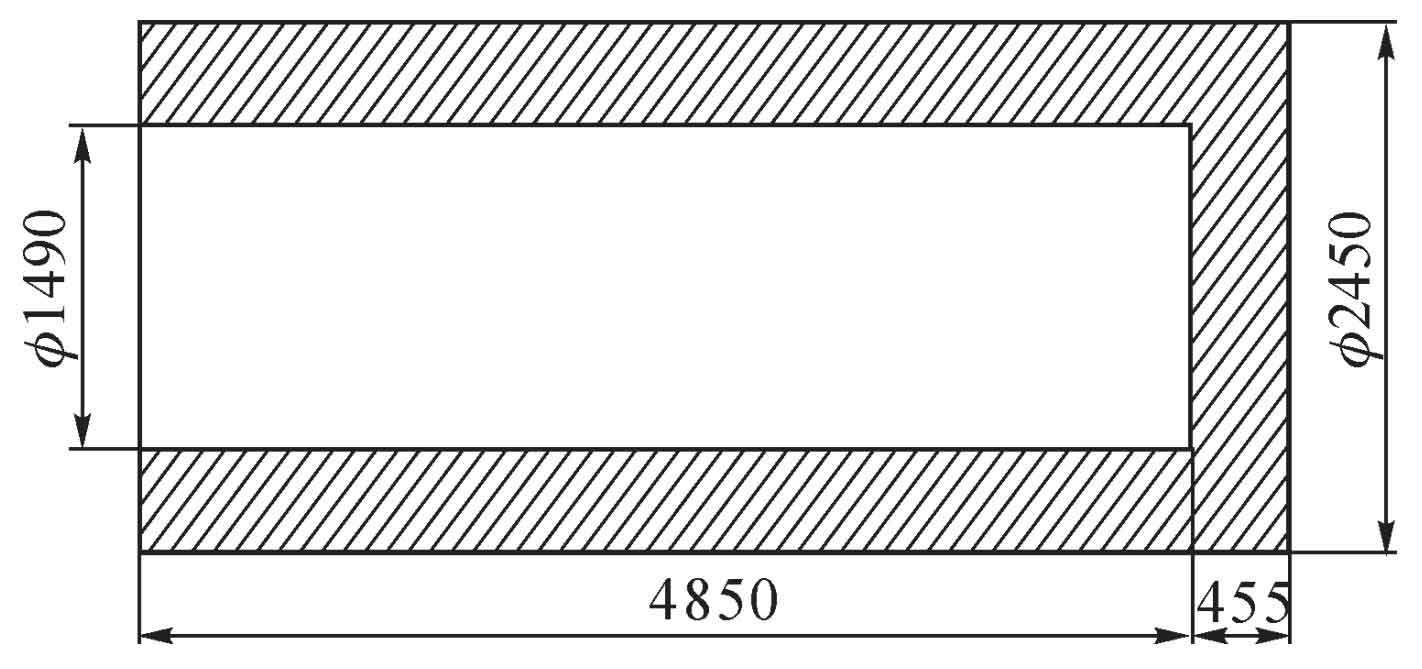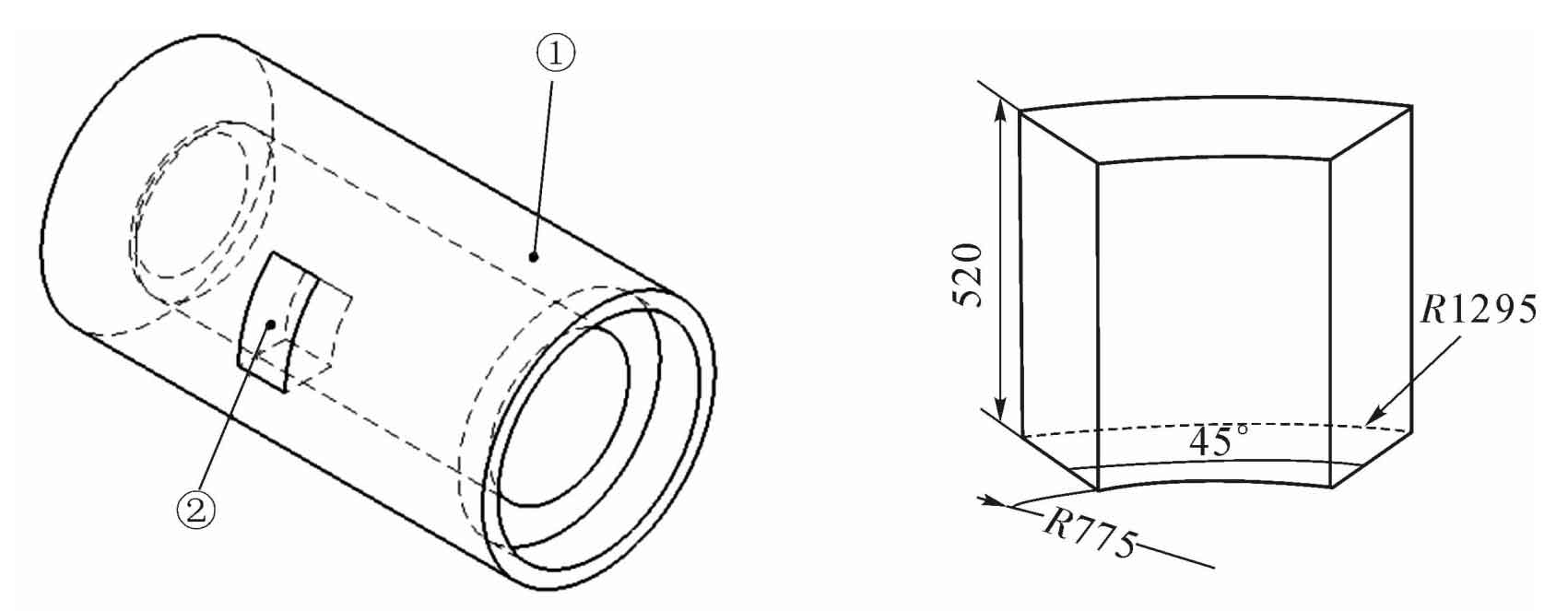In the 1980s, Siempelkamp company of Germany successfully developed castor series nodular cast iron transport containers. Compared with other metal containers, nodular cast iron container is a container with a single shell. Its high integrity makes it have better shielding performance. At the same time, it has shorter manufacturing cycle and lower manufacturing cost than other metal containers. Although the processing of ductile iron container is relatively simple, there are still some problems in the casting technology of thick and large section ductile iron. It is mainly manifested in that the wall is too thick and the solidification rate is small, resulting in a large tendency of element segregation in the thick part. It is easy to produce pearlite structure, poor mechanical properties and solidification defects. Figure 1 shows the structure and size of the simulated cast ductile iron transport container of Nippon Steel (hereinafter referred to as Nippon Steel), with a wall thickness of 480mm.
1. Technical requirements for nodular cast iron
As a special functional container, the technical standard of spent fuel transportation container is much higher than that of general engineering materials. There are corresponding inspection standards for spent fuel transport containers at home and abroad. The requirements of GB / t11806-2019 regulations on safe transportation of radioactive substances are: 9 m drop test, 1 m penetration test, 30 min fire test at 800 ℃ and 15 m underwater immersion test. Ensure the integrity of air tightness and shielding of the tank in case of possible accidents. Japanese Standard JIS g5504-2005 specifies the mechanical performance standard of spent fuel transportation container. The properties obtained by Nippon Steel, Muran Manufacturing Institute of Japan steel making Institute (hereinafter referred to as the steel making Institute) simulating ductile iron casting (cylindrical with bottom) and the actual tank of Siempelkamp company are shown in Table 1.
In addition, we should also ensure that the graphite shape, graphite size and ferrite content reach certain indexes, which need to be achieved by strictly controlling the composition of molten iron, solidification process and appropriate heat treatment.
2. Chemical composition of nodular cast iron
In order to obtain ideal mechanical properties, reasonable selection of chemical composition is very important. C. Si, Mn, s, P and other elements have significant effects on the microstructure of nodular iron castings. The content of Si will affect the tensile and yield strength, and Mn will produce segregation and hinder the formation of graphite. In addition, the combination of trace elements is an important factor causing defects. Si, Ca and CE can promote the formation of flake graphite at the thick wall, and as and sb can promote the precipitation of flake graphite between grains. Sappok found that the addition of CE can balance the harmful effects of Pb, as, Ti and Sb, and the percentage of coarse graphite decreases with the addition of CE.
At the same time, the N content must be kept within the appropriate range, because the N content is higher than 120 × 10-4%, defects will occur in thick wall ductile iron castings; If less than 80 × 10-4% will reduce the mechanical properties of nodular iron castings. Due to the enrichment of impurity elements, decaying graphite structure will be produced in the finally solidified molten iron. Therefore, reducing impurity content and preventing grain boundary segregation are the main measures to improve the toughness of the container. Table 2 shows the maximum control range of trace elements.
In order to ensure that its low-temperature impact toughness meets the requirements, in addition to using high-purity pig iron, the impurities in spheroidizing agent and inoculant should also be strictly controlled to ensure the high-temperature pure and high-quality molten iron meeting the composition requirements, so as to achieve the purpose of controlling chemical composition and trace elements.
Table 3 shows the chemical composition required by Japanese standard jisg5504 for nodular cast iron for spent fuel transportation, as well as the chemical composition of molten iron ladle and gate during Nippon Steel production. Siempelkamp company uses G40 3 Ferritic Ductile iron.
3. Solidification time of nodular cast iron
Nodular cast iron storage and transportation containers have large wall thickness and weight, long solidification time, especially the liquid iron in the center or hot spot remains in liquid state for a long time, long eutectic solidification time, spheroidization recession occurs, resulting in the decrease of spheroidization rate. In general, the cooling speed is slow, the solidification time is long, and ferrite is easy to form. However, according to the previous situation, it is found that pearlite structure is easy to appear in the wall thickness center of thick and large section ductile iron. When the solidification time is longer, it is easier to appear burst and fragment graphite. At the same time, in order to obtain the ideal matrix structure and spheroidizing effect, in addition to controlling the metallurgical factors such as liquid iron composition, the solidification time of nodular iron castings should be shortened as much as possible.
For Ferritic Ductile Iron, with the increase of solidification time, the number of graphite balls decreases, the ball diameter increases, the distorted graphite increases, and the tensile and fatigue properties become worse. The solidification time of large ductile iron spent fuel storage and transportation container is longer and the enthalpy is greater, which leads to the deterioration of microstructure and properties, and the low-temperature toughness is difficult to control. In order to prevent spheroidizing decline and obtain thick and large section ductile iron castings with good properties, appropriate processes must be adopted to speed up the cooling rate. It is difficult to solidify nodular iron castings in two hours by sand casting. Hanging external cooling iron on the outer surface of nodular iron castings can significantly accelerate the cooling speed of nodular iron castings. However, the size of thick and large section nodular iron simulation test block is large, and the size of cooling iron and sand mold are also increased accordingly. If the size of cold iron is too small and the heat storage capacity is insufficient, it can not meet the requirements of experimental design. In actual production, forced cooling is often used to prepare super large section ductile iron, such as zirconium sand with good thermal conductivity, cold iron and metal mold.
4. Heat treatment of nodular cast iron
The spent fuel storage and transportation tank produced by Siempelkamp company in Germany is usually used in as cast state. In order to obtain better performance, the ductile iron tank can be ferritized by heat treatment. BHQ and Nippon Steel Annealed at 900 ℃ are used_ Type 21 small spent fuel transport container is annealed at 780 ℃, and the content of ferrite in metallographic structure is more than 90% after heat treatment. In the production process, the uncooled nodular iron castings can be sent to the heat treatment workshop as soon as possible.
5. Ductile iron simulation casting
The simulated ductile iron casting test research on the material of ductile iron nuclear spent fuel transport container with 45 ° test block has been completed. The sample location, shape and size are shown in Figure 2. With high-purity pig iron as the main raw material, 75 ferrosilicon, mgre6-1 rare earth magnesium spheroidizing agent, high calcium barium inoculant and sulfur oxygen inoculant are used for metallurgical treatment. The material brand is qt400-18 and the casting mold is metal mold. See Table 4 for specific mechanical properties.






